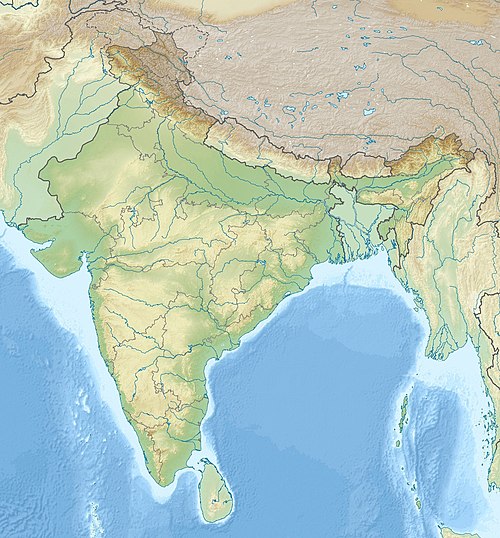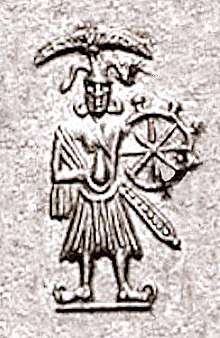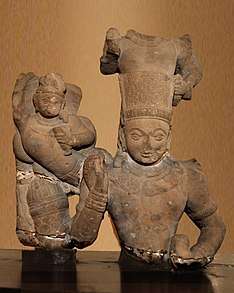Vasu Doorjamb Inscription
The Vasu Doorjamb Inscription is an early 1st-century CE Sanskrit inscription in Brahmi script dedicated to the deity Vāsudeva, related to the Vaishnavism tradition of Hinduism.[1][2] It is also one of the several dedicatory inscriptions from Mathura bearing the name of the Indo-Scythian Northern Satrap ruler Sodasa, which are useful as historic markers for the first half of the 1st century CE.[3]
| Vasu Doorjamb Inscription | |
|---|---|
 1st century CE Sanskrit inscription | |
| Material | Red Sandstone |
| Writing | Sanskrit, Brahmi script |
| Created | Circa 15 CE (reign of Sodasa) |
| Place | Mathura, Uttar Pradesh |
| Present location | Government Museum, Mathura |
| Identification | GMM 13.367 |
 Mathura Mathura (India) | |
The inscription was found on a red sandstone temple doorjamb dumped in an old well in Mathura, Uttar Pradesh.[4][5] The doorjamb is about 8 feet (2.4 m) long, 1.24 feet (0.38 m) wide and 8 inches (200 mm) thick. It is intricately carved on one side while the other side is flat. On the flat side, British India era archaeologists discovered that there is a 12-line inscription, which has been named the Vasu Doorjamb Inscription. The artifact is now at the Mathura Museum and a much studied item. It mentions a 1st-century Vishnu temple, a torana (temple gateway) and a vedika (railing).[6][7]
The Vasu Doorjamb Inscription is another archaeological evidence about ancient Vaishnavism, providing another link about the continuity between ancient religious traditions and contemporary Hinduism.[8][9][6]
Date
According to Richard Salomon, the inscription is from the time of the Indo-Scythian Northern Satrap Sodasa, or early years of the 1st-century CE.[1] The name of the ruler appears with his full title (Middle Brahmi script: ![]()
![]()
![]()
![]()
![]()
![]()
![]()
![]()
![]()
![]()
![]()
![]()

The name "Sodasa" (Śodāsa) in the Vasu doorjamb inscription.
According to Quintanilla, beyond the name, the style of the doorjamb and the carving on it is similar to that found in pieces recovered from closeby locations at the Mathura archaeological site such as the Jain Parshvanatha ayagapata and the Namdighosa ayagapata.[13] These too are dated to the early decades of the 1st-century CE.[14] However, Joanna Williams split-dates the Vasu Doorjamb, stating that the inscription is from early 1st-century CE but the carving may be from the 3rd-century CE because the intricate relief on Vasu doorjamb is more sophisticated, reminding one of the elegance of the early Gupta artists.[15] Quintilla, in contrast, states that the piece was likely carved and inscribed together prior to its installation in 1st-century CE because there are stylistic differences between the Vasu Doorjamb carvings and those found in the 3rd-century pieces. She states that the similarity in Jain reliefs of the 1st-century CE suggests it more likely that the Vasu piece too was prepared and installed in the 1st-century.[16]
Inscription
The discovered inscription is damaged, with parts so defaced that they cannot be read. Out of twelve lines, the first five are too damaged to be analyzed. The last seven lines have attracted scholarly studies. Since its discovery, its antiquity and significance has led scholars to interpret it as is, as well as make best guess interpolations and reconstruction followed by a revised translation.[2][4]
| Translation (without interpolation) | Transliteration | Early Brahmi script | Inscription (Prakrit in the Middle Brahmi script) |
|---|---|---|---|
|
|
|
|

The decipherable part confirms that a torana (gateway) and Vasu temple was established, and that this happened in the time of Sodasa thereby providing a basis to date the inscription.
According to Chakravarti, the first five lines are too damaged for any reliable translation. Further, no name can be deciphered from the inscription with complete certainty, including the donor name "Vasu" because it could be a compound name with -vasu. However, states Chakravarti, the inscription indicates that the donor had a name that is typically identified as "a Hindu name".[19]
With interpolation and extrapolation
Luders and Janert utilized the faded characters, the context and Sanskrit grammar rules to propose a reconstruction:[4][20]
1. (s)[v](amisya mahaksatrapasya Soda-)[note 2]
2. sa [s]ya... (... di-)
3. [vas](e)...
4. [p]...[na] Si[v]a (...)
5. sapu[t]r[e]na kausi[ki] (putrena)
6. vasuna bhaga[va] (to vasude-)
7. vasya mahasthana (. . . sai)[note 3]
8. lam toranam ve(dika ca prati-)
9. sthapito prito [bha] (gavan vasu-)
10. devah svami[sya] (mahaksatra-)
11. pasya soda[sa](sya . . .)
12. samvartayatam– Reconstructed Inscription, 1st-century CE[4]
Translation of reconstructed inscription
Sonya Quintanilla, in 2007, translated the last seven lines as:[4]
. . . a stone torana and railing were caused to be erected by Vasu at the . . . of the great temple of lord Vasudeva. May lord Vàsudeva, being pleased, promote (the dominion or life or vigor) of Svami Mahaksatrapa Sodasa.
Ramaprasad Chanda, in 1920, translated the same lines to:[21]
By ... vasu a quadrangle enclosed by four buildings (chatuhsalam), a pillared gateway (toranam) and a square terrace in the middle of courtyard (vedikah) have been built (at the shrine at) the great place of the Bhagavat Vasudeva. May Vasudeva be pleased. May (the dominion) of the lord, the mahakshatrapa Sodasa, endure.
NP Chakravarti, in 1942, disagreed with Chanda's interpolation of -lam to chatuhsalam because that "term never occurs in inscriptions of this time". He suggested that an interpolation to Devakulam, or even better Sailam, is more likely. Chakravarti translated the same lines to:[19]
... by Vasu, a gateway of stone (?) and the railing was erected at the... of the great temple of bhagavat Vasudeva. May bhagavat Vasudeva, being pleased, promote (the dominion or the life and strength) of svamin mahakshatrapa Sodasa.
Significance
The Vasu Doorjamb Inscription is a significant early Sanskrit inscription from Mathura. The mention of Sodasa's time who, states Salomon, is "dated with reasonable certainty to the early early years of the first century AD".[1] Its mention of Vasu, temple, Vedika and a torana (gateway) is significant as it confirms that the large temple building tradition was in vogue in the Mathura region by at least the start of the common era. Further, it also attests to the popularity of Vasudeva (Krishna) tradition in this period.[17][25] The Vasu Doorjamb inscription of Sodasa in Uttar Pradesh viewed with other epigraphical evidence such as the Besnagar Heliodorus pillar in Madhya Pradesh, the Hathibada Ghosundi Inscriptions in Rajasthan, and the Naneghat inscriptions in Maharashtra suggest that the cult of Vasudeva-Krishna and early Vaishnavism had spread over a wide region by the 1st-century BCE to the start of common era.[25][2]
According to Quintanilla, the Vasu Doorjamb and the inscription is "one of the most important and most beautiful objects" from the time of Sodasa, likely from a "temple to Vāsudeva", another name for Vishnu.[26] The carvings on the doorjamb are three woven compositions. It has a leafy vine that runs along the length of the red sandstone jamb. Along the stem of the vine are curling leaves and blossoms, that wrap along as those found in nature, a rosette added in where the intertwining vines meet.[27][28] The wider band has lotus rhizome carved in, with subtle naturalistic variations, wherein the lotus flowers are shown in all their stages of bloom, states Quintanilla.[27]
See also
Notes
References
| Part of a series on |
| Vaishnavism |
|---|
 |
|
Holy scriptures
|
|
Sampradayas
|
|
Related traditions |
|
|
- Richard Salomon 1998, pp. 87-88.
- Ramaprasad Chanda 1920, pp. 169-173.
- Sonya Rhie Quintanilla 2007, pp. 168-179.
- Sonya Rhie Quintanilla 2007, pp. 262-263.
- Sahni 1917, p. 10.
- Sonya Rhie Quintanilla 2007, pp. 205-206, 262-263.
- Michael Willis 2000, p. 62.
- Ramaprasad Chanda 1920, pp. 151-173.
- NP Chakravarti 1942, pp. 208-210.
- Buddhist art of Mathurā , Ramesh Chandra Sharma, Agam, 1984 Page 26
- Quintanilla, Sonya Rhie (2007). History of Early Stone Sculpture at Mathura: Ca. 150 BCE - 100 CE. BRILL. p. 205. ISBN 9789004155374.
- Sonya Rhie Quintanilla 2007, pp. 170-171.
- Photograph of the Namdighosa ayagapata Fig. 20 in Quintanilla, Sonya Rhie (2000). "Āyāgapaṭas: Characteristics, Symbolism, and Chronology". Artibus Asiae. 60 (1): 79–137. doi:10.2307/3249941. ISSN 0004-3648. JSTOR 3249941.
- Sonya Rhie Quintanilla 2007, p. xxxii, caption; 125.
- Joanna Williams 1982, pp. 13-14.
- Sonya Rhie Quintanilla 2007, pp. 125-126, 135-136, 153, 199-200.
- Ramaprasad Chanda 1920, p. 170.
- NP Chakravarti 1942, p. 208.
- NP Chakravarti 1942, p. 209.
- Heinrich Lüders & Klaus Ludwig Janert 1961, p. 155.
- Ramaprasad Chanda 1920, p. 171.
- Singh, Upinder (2008). A History of Ancient and Early Medieval India: From the Stone Age to the 12th Century. Pearson Education India. p. 437. ISBN 978-81-317-1120-0.
- Joshi, Nilakanth Purushottam (1979). Iconography of Balarāma. Abhinav Publications. p. 22. ISBN 978-81-7017-107-2.
- Paul, Pran Gopal; Paul, Debjani (1989). "Brahmanical Imagery in the Kuṣāṇa Art of Mathurā: Tradition and Innovations". East and West. 39 (1/4): 132–136, for the photograph p.138. ISSN 0012-8376. JSTOR 29756891.
- Upinder Singh 2008, p. 437.
- Quintanilla, Sonya Rhie (2007). History of Early Stone Sculpture at Mathura: Ca. 150 BCE - 100 CE. BRILL. p. 205. ISBN 978-90-04-15537-4.
- Sonya Rhie Quintanilla 2007, pp. 205-206.
- Ramesh Chandra Sharma 1994, p. 72.
Bibliography
- NP Chakravarti (1942). Epigraphia Indica, Vol. XXIV. Archaeological Survey of India.CS1 maint: ref=harv (link)
- Ramaprasad Chanda (1920). Archaeology and Vaishnava Tradition in MASI, No. 5. Archaeological Survey of India. OCLC 715446015.CS1 maint: ref=harv (link)
- Heinrich Lüders; Klaus Ludwig Janert (1961), Mathurā inscriptions, Göttingen : Vandenhoeck & Ruprecht, OCLC 717966622
- Sonya Rhie Quintanilla (2007). History of Early Stone Sculpture at Mathura: ca. 150 BCE - 100 CE. BRILL Academic. ISBN 978-90-04-15537-4.CS1 maint: ref=harv (link)
- Sahni, Daya Ram (1917). Annual Progress Report of the Superintendent, Hindu and Buddhist Monuments, North Circle. Government Press Punjab, Lahore. hdl:2027/uc1.c2999464.CS1 maint: ref=harv (link)
- Richard Salomon (1998). Indian Epigraphy: A Guide to the Study of Inscriptions in Sanskrit, Prakrit, and the other Indo-Aryan Languages. Oxford University Press. ISBN 978-0-19-535666-3.CS1 maint: ref=harv (link)
- Ramesh Chandra Sharma (1994). The Splendour of Mathurā Art and Museum. DK Printworld. ISBN 978-81-246-0015-3.CS1 maint: ref=harv (link)
- Upinder Singh (2008). A History of Ancient and Early Medieval India: From the Stone Age to the 12th Century. Pearson Education India. ISBN 978-81-317-1120-0.CS1 maint: ref=harv (link)
- Joanna Williams (1982). The Art of Gupta India: Empire and Province. Princeton University Press. ISBN 978-0-691-10126-2.CS1 maint: ref=harv (link)
- Michael Willis (2000). Buddhist Reliquaries from Ancient India. British Museum Press. ISBN 978-0-7141-1492-7.CS1 maint: ref=harv (link)





